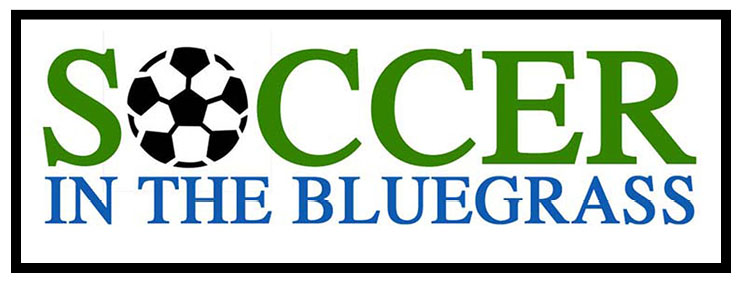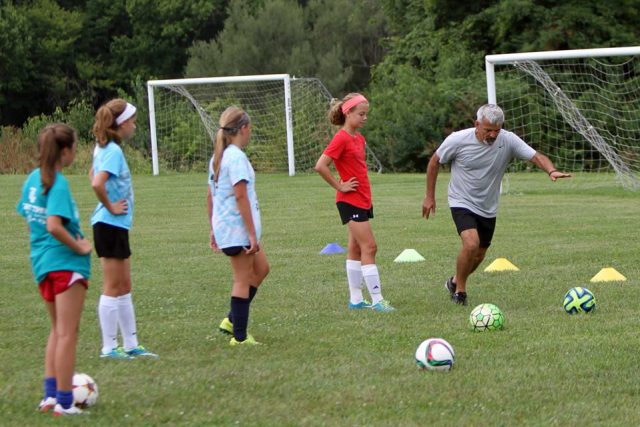This website, Soccer in the Bluegrass, aims to be a celebration of soccer. Playing it, learning it, coaching it and watching it. Whether you have a three-year-old with his or her first ball or a teen looking to improve their skill or fitness level, Soccer in the Bluegrass will be a site where you can find the resources, news and information you need to get playing, and a place where we can have fun talking about and celebrating the game at all levels.
Hi, my name is Cary Tsamas.
 I have been a soccer coach for more than 25 years and an artist ever since I attended Greek elementary school where I drew maps for homework with my dad. I got my start in coaching as a volunteer for the Lexington Youth Soccer Association. I have been coaching at many levels, including club, high school and college. I was even the general manager of a semi-pro team in Lexington, the Bluegrass Bandits.
I have been a soccer coach for more than 25 years and an artist ever since I attended Greek elementary school where I drew maps for homework with my dad. I got my start in coaching as a volunteer for the Lexington Youth Soccer Association. I have been coaching at many levels, including club, high school and college. I was even the general manager of a semi-pro team in Lexington, the Bluegrass Bandits.
In conjunction with this new website, I’m also restarting The Art of Soccer Academy in a new facility, where I offer small group and individual sessions to develop players’ technical skill. Tactics may vary from coach to coach but the need for players to execute a particular skill, dribbling, receiving, passing, shooting, heading, remains the same. There is nothing that indicates the player’s skill level like their “first touch” on the ball. It is the first touch that will determine whether the player will maintain control of the ball or whether the player will lose possession.
Being able to execute these skills and do so under pressure is what coaches at all levels look for in a player, along with size, speed and strength (both physical and mental). There are coaches throughout Central Kentucky who can help you with all those aspects of being a soccer player. Soccer in the Bluegrass will point you there. I hope The Art of Soccer will be on your list.
My story
I grew up playing soccer in Giannitsa, a town in the northern region of Macedonia, Greece. It was something we did at recess, after school, before dinner. We played in the parks, in the streets, sometimes bare-footed. We did NOT have shin guards! We would gather in the neighborhood, and depending on how many showed up, play 1v1, 2v2, and so on. If you came with a ball, you were guaranteed a spot on a team with the best player – even if you were the worst player out there. Otherwise, you were just picked last so the teams would be even.
We had no coaches, no team coordinators, no uniforms. You played till it got dark or your mother called you in for dinner. It was bad if you were the first to leave. That meant someone from the other team had to sit out. If you had to leave early AND were the guy with the ball, well … you just ended the game for everybody! As you can tell, the guy with the ball wielded a lot of power.
Sometimes only two people would show up. So we would have juggling contests. How many times can you juggle the ball with only the laces, or only the laces but only one foot. Thigh juggles. Headers. Have you ever tried juggling the ball with only the laces, only with your left (right) foot and tried to get 100 juggles? 200? Nothing is better for building strength, balance and the first touch.
Of course we didn’t see it like that. We were just playing.
Fast forward a few years. In 1991, for the first time, I became a LYSA volunteer coach and started a new journey. I coached the Sayre High School boys’ team for 11 years, a Berea College women’s team coach for nine years and been a club coach (boy’s and girls) for over 20 years. I have seen, first hand, how players develop and the system within which this development takes place.
Wow! What a stark difference in how one learns to play the game in the United States and abroad. Here I must recognize all the parents who volunteer their time, effort, and money, so that they can coach their kid. Back in 1991, the parents coaching 5-, 6-, 7-year-olds had never played the game. They just saw it as a way for their child to get exercise, it was relatively safe, and it didn’t cost a lot. So, they went to the library, checked out a couple of books, learned the rules, and away they went. Actually, that’s a very big reason why it was so readily adopted by the high schools when I was starting out.
Now, we can do much more. The popularity of soccer has grown tremendously over the years. We are part of that growth. And we can spur it along. Soccer in the Bluegrass is going to have a lot of fun doing just that.









